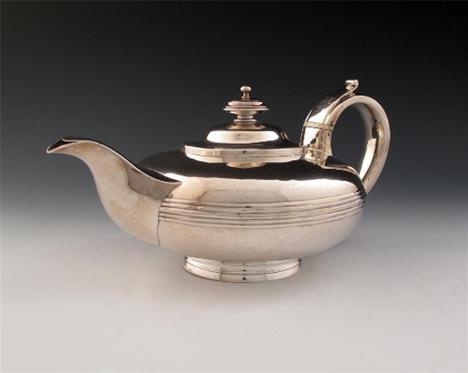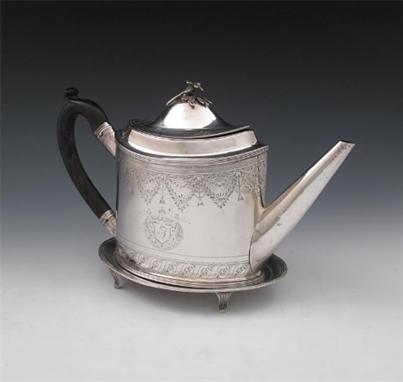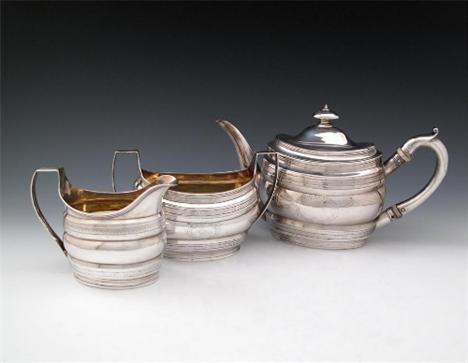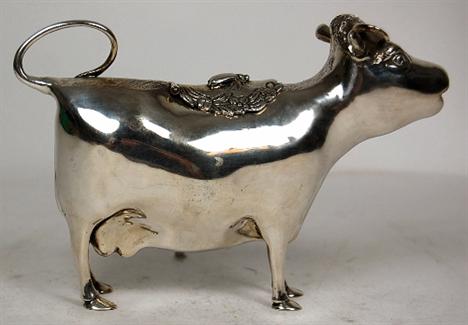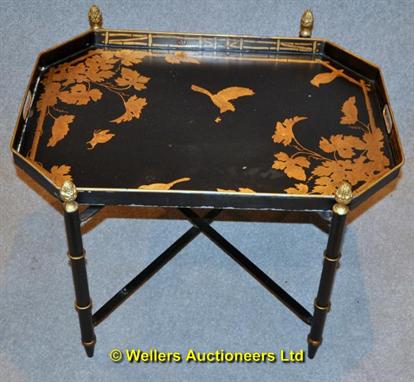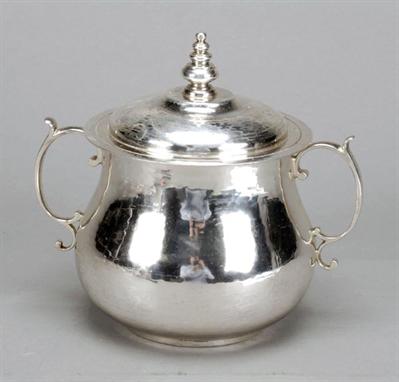We found 116003 price guide item(s) matching your search
There are 116003 lots that match your search criteria. Subscribe now to get instant access to the full price guide service.
Click here to subscribe- List
- Grid
-
116003 item(s)/page
A George II silver coffee pot, by Gabriel Sleath, London 1729, tapering circular form, with a wooden side handle, domed hinged cover with a knop finial, engraved with an armorial with foliate scroll mantling, height 21.5cm, approx. weight 22oz. ** The arms are those of Hasley of Suffolk impaling Knight of Northants.
A late-Victorian silver tea caddy, by Thomas Hayes, Birmingham 1899, rounded rectangular form, embossed foliate decoration, the hinged cover with an urn finial, plus a late-Victorian silver tea canister of square form, embossed foliate decoration, London 1890, by William Comyns, approx. total weight 10oz. (2)
An 18th century silver tea caddy, the slide off base with maker`s mark of John Newton, oval cylindrical form, later embossed with foliate scroll decoration, the pull off cover with a knop finial, engraved with an armorial, height 13.8cm, approx. weight 7.5oz. ** The arms are those of Boughton of Suffolk engraved on a lozenge for a spinster.
A pair of George III silver-gilt tea caddies, by Samuel Taylor, London 1765, baluster form, embossed and chased with Chinoserie figures and classical settings, within foliate borders, the pull-off covers with a flower finial, on raised circular pierced foliate scroll bases, engraved with an armorial, height 13.5cm, approx. weight 22oz. (2)
A George III silver teapot and stand, by Peter and Ann Bateman, London 1796, oval form, with bright-cut foliate decoration and stylised borders, the domed hinged cover with a flower finial, reeded borders, initialled, the stand on four bracket feet, length handle to handle 28cm, approx. weight 18oz. (2)
A George III silver tea urn, by Thomas Whipham and Charles Wright, London 1767, inverted pear form, oak leaf and branch scroll handles, gadroon borders, domed pull-off cover with a foliate scroll finial, the foliate scroll capped spout with an ivory tap, engraved with an armorial, on a raised shaped square base with a pierced foliate scroll apron, on four pierced bracket feet, height 52.5cm, approx. weight 100oz. ** The arms are those of Cox of Chichester impaling Thurwall and Whitelaw.
A William IV silver mounted Ostrich egg sugar vase and cover, by John Figg, London 1835, the egg supported with strap work, on a raised circular foot with a gadroon border, the pull-off cover with an ostrich finial, the interior gilded, the cover and side with an opening for a sugar spoon, height 33.5cm.
A George II silver-gilt cup and cover, the cover marked four times with maker`s mark of George Wickes, the cup unmarked, London circa 1735, circular form, central girdle, leaf capped scroll handles, with applied cast cut card strap-work decoration, engraved trellis and foliate decoration, engraved with an early 19th century crest and monogram, the pull-off cover with strap-work decoration and knop finial, on a raised circular foot with chased decoration, height 37.5cm, approx. weight 160oz. ** Engraved with the initials APD and a crest recorded for Boats of Dublin. Provenance: Purchased from Sotheby`s London, Fine Silver, 2 June 1992, lot 169.
A matched pair of George II and George III cast silver two-light candelabra, by Charles Kandler II, London 1783, one base by Paul Crespin, London 1748, shaped baluster stems with foliate scroll decoration and with three female busts supporting scroll capitals, on raised hexafoil bases with reeded borders and strapwork, foliate double scroll branches, each with a female bust supporting scroll capitals and hexafoil drip pans, central foliate finial, engraved with a crest and coronet, the earlier base inscribed to underside, ` Part of 2,381,000 oz of Spanish silver taken by the Prince Frederick & Duke Privateers, Amicitiae Causa`, also number `No.4` and with a scratch weight `36=5½`, the other base inscribed `No 3` and `34=2`, height 43.5cm and 42.8cm, approx. weight 168oz. (2) ** Provenance Purchased from Sotheby`s, New Bond Street, London, Fine Silver Sale, 7 November 1996, lot 185. The crest is that of Murray, Earls of Mansfield, probably for William, 1st Earl of Mansfield (1705-1793). He was born at Scone in 1705, and he pursued a distinguished legal career following being called to the English Bar in 1730. He became the Solicitor General in 1742, Attorney-General in 1754 and Lord Chief Justice of England in 1756. He died in 1793. the inscription refers to the action of 10 July , 1745, when the Privateers `Prince Frederick` commanded by Captain James Talbot and `Duke` by Captain John Morecock sighted three vessels whilst cruising the North Atlantic. They turned out to be French armed treasure ships returning from Lima- the `Louis Erasme`, `Marquis d`Antin` and `Notre Dame`. Talbot attacked immediately and captured first teh Marquis `Antin and then `Louis Erasme at one time being lodged between the two. The value of treasure captured from the two vessels amounted to £800,000 and was paraded through London in forty-five wagons on its journey to the tower.
AN 18TH CENTURY WELSH OAK LONGCASE CLOCK, having broken swan neck pediment with brass urn shaped vase shaped finial surmounted by bird, arched aperture flanked by plain turned columns, moulded waist door flanked by reeded quarter pilasters on a panel base with bracket feet. Arch brass face with mask and dolphin spandrels, tempus fugit panel to the arch and seconds with date dials to the field. Eight day movement striking on one bell. Unnamed. C1790. Face 17.5" x 12", overall 92" High.
A CHAMBERLAIN'S (WORCESTER) CRESTED ICE-PAIL, COVER AND LINER CIRCA 1805-10, BLACK PRINTED MARK The cover with gilt dolphin finial, a pierced gallery to the rim, painted with the crest of a soldier with flaming torch and motto 'Virtus Invicta Gloriosa', on a salmon-pink ground gilt with foliate design, applied with two shell handles (3) View on Christie's.com
A SILVER COFFEE POT AND HOT WATER JUG IN THE EARLY 18TH CENTURY STYLE MARK OF J. PARKES AND CO., LONDON, RESPECTIVELY 1929 AND 1925 Each with plain tapering sides and double knop finial; also a small silver two-handled tray by Charles Clement Pilling, London, 1903, gadroon borders with shell and foliate corners The coffee pot, 9 3/8 in. (23.8 cm.) high; the tray, 22¼ in. (56.5 cm.) long 112 oz. (3,472 gr.) (3) View on Christie's.com
A GEORGE IV SILVER MATCHED THREE-PIECE TEA SET THE TEAPOT, MARK OF JOHN JAMES KEITH, LONDON, 1826, THE CREAM JUG AND SUGAR BOWL, MAKER'S MARK INDISTINCT, LONDON, CIRCA 1825 Squat circular, the fluted sides centred by crested foliate cartouches, scroll borders interspersed with flowerheads, on four foliate shell feet, the teapot with ivory insulators to handle and finial The teapot, 6 in. (15.3 cm.) high 48.5 oz. (1,504 gr.) (3) View on Christie's.com
THREE SILVER-PLATED KETTLES ON STANDS SECOND HALF OF 19TH CENTURY Comprising one Victorian example by Martin Hall & Co., circa 1875, with engraved decoration, the spirit stand with pierced sides, another of squat circular melon-fluted form with engraved scrollwork and seated Chinaman finial, crested, circa 1860 and a Continental example with ivory grip and gilt leafy pod finial, cover engraved with coronet and initials, circa 1880 Tallest 17¼ in. high (44 cm.) (3) View on Christie's.com
2 rare Bing ‘O’ gauge tinplate Train Indicators. A black column surmounted with a clock and finial with ‘Next Train To’ facility and 6 destination boards in lower racks, showing for example ‘Leicester-Derby-Manchester’. Secured to a square brown base. Also a black coloured board and cupboard type Train Indicator, with four platform positions, clocks and destination boards, showing for example ‘Trent’. GC-VGC. Plate. 3
A set of six Victorian Baronial oak side chairs each with floral carved top-rail and cushioned back flanked by barley sugar twist supports over a green cushioned seat with shaped apron raised on carved tapering octagonal legs terminating in bun feet and united by shaped X-frame stretchers mounted with a central urn finial (6)
A Late Victorian mantle clock William Comyns, London 1899, retailed by Edwards and Sons Glasgow, the dial with Roman numerals with swag and floral pendant decorations, the full silver case with scrolling borders and embossed courtly and landscape scenes, with presentation inscription to front, the whole raised on open bracket feet and with urn finial 32cm high
An interesting unmarked scent bottle the fluted body with traces of gilding, the screw off cover with loop finial, engraved to base MR in script within foliate surround; together with a late Victorian box, of simple cylindrical form with presentation inscription and the pull off cover embossed with a winged figure (2) scent 5cm high
A silver plated serving dish stand and burner of rectangular outline with simple beaded border and loop handles, with slightly domed cover and square finial, raised on simple frame with reeded supports and centrally fitted spirit burner; together with a plated tankard, pair of comports and sugar basket (5)
A Continental, probably French wrought iron lenticular lamp, first half 19th century, of typical form with swing handle above the cushion form reservoir, the filling plate with cockerel finial, 26.5cm high including hanging attachments, 12.5cm wide. Comparative Literature: Cf. John Caspall, Making Fire and Light in the Home pre-1820, Antique Collectors’ Club, 1987. See p221 for a very similar example. Lamps of this type were produced throughout Continental Europe, probably for mining use.
A Meissen garniture de chiminee of three baluster vases and covers and two beaker vases, painted with chinoiserie panels of oriental figures within bold brown and gilt ombrierte cartouches in the manner of P.E. Schindler, each surrounded by scattered sprays of deutsche Blumen, the central vase and cover, 54cm high, blue crossed swords marks (cover finial repaired), the two smaller baluster vases and covers, 45cm and 46cm high, blue crossed swords marks (one finial restored and one with restored area to neck rim), the beaker vases, 41.5cm and 42cm high, probably late 19th century. On the instructions of the Administrators of Partridge Fine Art Ltd (in Administration).
A Victorian silver oval half reeded teapot by Charles Stuart Harris, London 1888, with composition lobed finial and harp shaped handle, on a collet foot, engraved with a crest and legend ‘Nobilis est ira leonis’, 24.5cm, 9.75in long, 510g (16.6oz) gross. The crest and motto of this teapot belongs to the name of Stuart, kinsman of the Marquesses of Bute who use this crest and motto along with another crest and motto for CRICHTON. The first husband of Mrs Knatchbull-Hugessen (Ropley House) was Lord James Charles Crichton-Stuart, son of Sir John Crichton-Stuart, 5th Marquess of Bute and Lady Eileen Beatrice Forbes. In 1947 ownership of Dumfries House passed to Sir John Crichton-Stuart,5th Marquess of Bute and upon his death in 1956, the Dowager Marchioness of Bute returned to live at Dumfries House.
A William IV silver three piece tea set by Edward, Edward Jr, John and William Barnard, London 1835, the compressed circular bodies with shaped, everted rims and engraved with scrolls, foliage and trellis work panels between mainly vacant cartouches, of a teapot with sprung domed cover to a whippet finial, engraved with a crest and initials TJC?, a two handled sugar basin with gilt interior, and a cream jug, the teapot 27.5cm (10.8in) long, 1395g (44.85oz) gross
-
116003 item(s)/page









